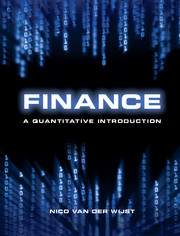Book contents
- Frontmatter
- Contents
- List of Figures
- List of Tables
- Acronyms
- Preface
- 1 Introduction
- 2 Fundamental concepts and techniques
- 3 Modern portfolio theory
- 4 Market efficiency
- Chapter 5 Capital structure and dividends
- 6 Valuing levered projects
- 7 Option pricing in discrete time
- 8 Option pricing in continuous time
- 9 Real options analysis
- 10 Selected option applications
- 11 Hedging
- 12 Agency problems and governance
- Solutions to exercises
- Glossary
- References
- Index
12 - Agency problems and governance
Published online by Cambridge University Press: 05 February 2013
- Frontmatter
- Contents
- List of Figures
- List of Tables
- Acronyms
- Preface
- 1 Introduction
- 2 Fundamental concepts and techniques
- 3 Modern portfolio theory
- 4 Market efficiency
- Chapter 5 Capital structure and dividends
- 6 Valuing levered projects
- 7 Option pricing in discrete time
- 8 Option pricing in continuous time
- 9 Real options analysis
- 10 Selected option applications
- 11 Hedging
- 12 Agency problems and governance
- Solutions to exercises
- Glossary
- References
- Index
Summary
The models that we have discussed so far are based on market equilibrium or the absence of arbitrage opportunities. In such models, market participants reach consensus about arbitrage-free or market clearing equilibrium prices, which ensure that each participant gets their fair share. For example, in the CAPM all securities are held at their equilibrium market prices. Similarly, in the trade-off theory’s optimal capital structure both equity and debt get their fair share of the firm’s revenue, viz. the market price of the risk they bear. The first cracks in this equilibrium approach appeared in the pecking order theory, where managers with inside information can increase the wealth of the existing shareholders by issuing new debt or equity at too high a price. The cracks widened when we modelled equity as a call option on the firm’s assets. We saw that equity holders can benefit at the expense of debtholders by choosing risky projects rather than safe ones. Such conflicts of interest are much more general. They are studied in agency theory, which looks at the firm as a team of different parties that realize their own interests by cooperating in the firm. That cooperation is governed by a set of contracts that specify how inputs are joined and outputs are distributed. The design of contracts that share risk and return in an optimal way is an important topic in agency theory. This chapter discusses some headlines of agency theory and its influence on the way firms are managed.
Agency theory
Agency theory has its roots in corporate governance theories that go back to the 1930s, but its application in finance is usually associated with Jensen and Meckling’s (1976) pioneering paper. Agency theory is very general – it applies in principle to all situations that involve cooperation. It has a long tradition in political science and labour market economics. We have met several elements of agency theory before; we now summarize them in an agency-theoretic perspective.
- Type
- Chapter
- Information
- FinanceA Quantitative Introduction, pp. 330 - 353Publisher: Cambridge University PressPrint publication year: 2013

